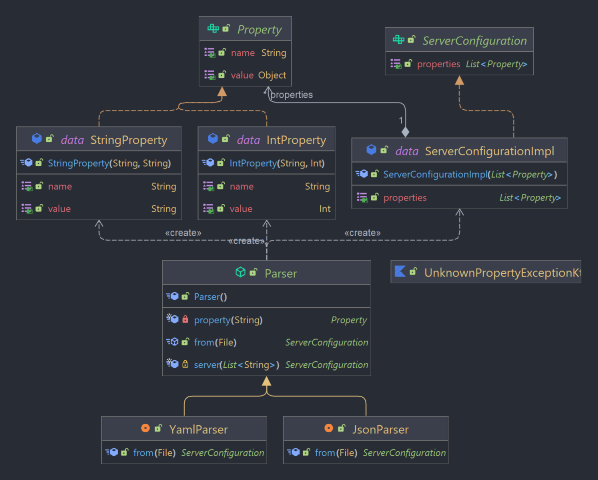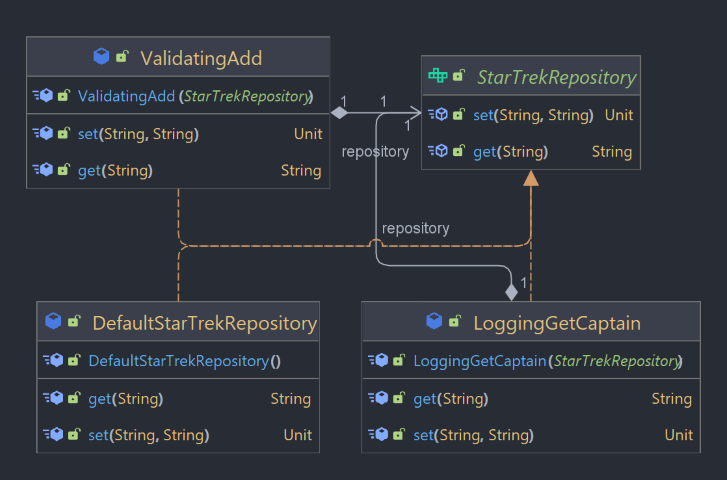Design Patterns are a proven way to solve common programming problems. These issues or questions will usually arise during the software development period for programmers. Pattern design solutions are typically using object-oriented.
- They are reusable in multiple projects.
- They provide the solutions that help to define the system architecture.
- They capture the software engineering experiences.
- They provide transparency to the design of an application.
- They are well-proved and testified solutions since they have been built upon the knowledge and experience of expert software developers.
- Decorator Pattern
- Adapter Pattern
- Bridge Pattern
- Composite Pattern
- Facade Pattern
- Flyweight Pattern
- Proxy Pattern
- Chain Of Responsibility Pattern
- Command Pattern
- Interpreter Pattern
- Iterator Pattern
- Mediator Pattern
- Memento Pattern
- Observer Pattern
- State Pattern
- Strategy Pattern
- Template Pattern
- Visitor Pattern
One of the sub-branches of Pattern Design is Creational Design Pattern. This pattern is a way to make things. This template is used when we want to create an object from a class in our program. But for many it may be very easy to build an object and just by new we create an object. But hard code is not a good solution Because we sometimes change the identity of a class in our code, and in such cases we have to use the Creational Design pattern.
The singleton pattern ensures that only one object of a particular class is ever created. All further references to object of the singleton class refer to the same underlying instance.
Example
object Logger {
init {
println("$this I was accessed for the first time")
}
fun log(massage: String) = println("$this massage = $massage")
}Usage
Logger.log("Hello World")
Logger.log("Hello Kotlin")Output
singleton.Logger@12f41634 I was accessed for the first time
singleton.Logger@12f41634 massage = Hello World
singleton.Logger@12f41634 massage = Hello Kotlin
The factory pattern is used to replace class constructors, abstracting the process of object generation so that the type of the object instantiated can be determined at run-time. we can also use sealed class.
Example
interface ChessPiece {
val file: Char
val rank: Char
}
data class Pawn(
override val file: Char,
override val rank: Char
) : ChessPiece
data class Queen(
override val file: Char,
override val rank: Char
) : ChessPiece
class UnknownPiece(message: String) : RuntimeException(message)
object ChessFactory { // Factory create chess piece
fun createPiece(notation: String): ChessPiece {
val (type, file, rank) = notation.toCharArray()
return when (type) {
'p' -> Pawn(file, rank)
'q' -> Queen(file, rank)
else -> throw UnknownPiece(type.toString())
}
}
}Usage
val notations = listOf("pa8", "qc3")
val pieces = mutableListOf<ChessPiece>()
for (n in notations) {
pieces.add(ChessFactory.createPiece(n))
}
println(pieces)Output
[Pawn(file=a, rank=8), Queen(file=c, rank=3)]
The abstract factory pattern is used to provide a client with a set of related or dependant objects. The "family" of objects created by the factory are determined at run-time.
Example
interface Property {
val name: String
val value: Any
}
data class IntProperty(
override val name: String,
override val value: Int
) : Property
data class StringProperty(
override val name: String,
override val value: String
) : Property
interface ServerConfiguration {
val properties: List<Property>
}
data class ServerConfigurationImpl(
override val properties: List<Property>
) : ServerConfiguration
typealias UnknownPropertyException = RuntimeException
abstract class Parser {
abstract fun from(file: File): ServerConfiguration
private fun property(prop: String): Property {
val (name, value) = prop.split(":")
return when (name) {
"port" -> IntProperty(name, value.trim().toInt())
"environment" -> StringProperty(name, value.trim())
else -> throw UnknownPropertyException("Unknown property:$name")
}
}
protected fun server(propertyStrings: List<String>): ServerConfiguration {
val parsedProperties = mutableListOf<Property>()
for (p in propertyStrings) {
parsedProperties += property(p)
}
return ServerConfigurationImpl(parsedProperties)
}
}
object YamlParser : Parser() {
override fun from(file: File): ServerConfiguration {
val propertyStrings = file.readLines().drop(1).map { it.trim() }
return server(propertyStrings)
}
}
object JsonParser : Parser() {
override fun from(file: File): ServerConfiguration {
val regex = """(\s|\{|}|"|,)*""".toRegex()
val lines = file.readLines()
val propertyStrings = lines.map { it.replace(regex, EMPTY) }.subList(2, lines.lastIndex - 1)
return server(propertyStrings)
}
private const val EMPTY = ""
}Usage
server:
port: 8080
environment: production{
"server": {
"port": 8080,
"environment": "production"
}
}val ymlPath = "configure.yml"
println(YamlParser.from(File(path)))
val jsonPath = "configure.json"
println(JsonParser.from(File(path)))Output
ServerConfigurationImpl(properties=[IntProperty(name=port, value=8080), StringProperty(name=environment, value=production)])
ServerConfigurationImpl(properties=[IntProperty(name=port, value=8080), StringProperty(name=environment, value=production)])
The builder pattern is used to create complex objects with constituent parts that must be created in the same order or using a specific algorithm. An external class controls the construction algorithm.
Example
data class Mail(
val to: List<String>,
val cc: List<String>? = null,
val title: String? = null,
val message: String? = null,
val important: Boolean = false
) {
fun send() = println("Mail Sent")
class Builder(initializer: Builder.() -> Unit = {}) {
private var to: List<String> = listOf()
private var cc: List<String>? = null
private var title: String? = null
private var message: String? = null
private var important: Boolean = false
init {
initializer()
}
fun to(to: List<String>) = apply { this.to = to }
fun cc(cc: List<String>) = apply { this.cc = cc }
fun title(title: String) = apply { this.title = title }
fun message(message: String) = apply { this.message = message }
fun important(important: Boolean) = apply { this.important = important }
fun build(): Mail {
require(to.isNotEmpty()) { "To property is empty" }
return Mail(to, cc, title, message, important)
}
}
}
fun mail(initializer: Mail.Builder.() -> Unit) = Mail.Builder(initializer).build()Usage
val mail = Mail(to = listOf("[email protected]"), title = "What's up?")
println(mail)
mail.send()
val mailFromBuilder = Mail.Builder()
.to(listOf("[email protected]"))
.message("Hi")
.build()
println(mailFromBuilder)
val mailFromDSLBuilder = Mail.Builder {
to(listOf("[email protected]"))
message("Hi")
}.build()
println(mailFromDSLBuilder)
val mailFromExt = mail {
to(listOf("[email protected]"))
cc(listOf())
title("???")
message("Hi")
important(true)
}
println(mailFromExt)Output
Mail(to=[[email protected]], cc=null, title=What's up?, message=null, important=false)
Mail Sent
Mail(to=[[email protected]], cc=null, title=null, message=Hi, important=false)
Mail(to=[[email protected]], cc=null, title=null, message=Hi, important=false)
Mail(to=[[email protected]], cc=[], title=???, message=Hi, important=true)
The purpose of a pattern prototype is that we do not create different objects of the
same class, simplify an object we have, and do not pay to build a new object.
we can also implement Cloneable class or use my_object.copy() in Kotlin.
Example
enum class Role {
ADMIN,
SUPER_ADMIN,
REGULAR_USER
}
data class User(
val name: String,
val role: Role,
private val permissions: Set<String>,
val tasks: List<String>,
) {
fun hasPermission(permission: String) = permission in permissions
}Usage
// In real application this would be a database of users
private val allUser = mutableListOf(
User(
name = "Ali",
role = Role.ADMIN,
permissions = setOf("edit", "delete"),
tasks = listOf("edit_users", "delete_users")
)
)
fun createUser(name: String, role: Role) {
for (user in allUser) {
if (user.role == role) {
allUser += user.copy(name = name)
return
}
}
// Handle case that no other user with such a role exists
}
createUser(name = "Reza", role = Role.ADMIN)Structural Patterns talk about objects and classes and how they combine. This pattern creates a simple structure to indicate the relationship of objects and classes to each other.
The decorator pattern is used to extend or alter the functionality of objects at run-time by wrapping them in an object of a decorator class. This provides a flexible alternative to using inheritance to modify behaviour.
Example
interface StarTrekRepository {
operator fun get(starShipName: String): String
operator fun set(starShipName: String, captainName: String)
}
class DefaultStarTrekRepository : StarTrekRepository {
private val starShipCaptains = mutableMapOf("USS Enterprise" to "Jean-Luc Picard")
override fun get(starShipName: String): String {
return starShipCaptains[starShipName] ?: "Unknown"
}
override fun set(starShipName: String, captainName: String) {
starShipCaptains[starShipName] = captainName
}
}
class LoggingGetCaptain(private val repository: StarTrekRepository) : StarTrekRepository by repository {
override fun get(starShipName: String): String {
println("Getting captain for $starShipName")
return repository[starShipName]
}
}
class ValidatingAdd(private val repository: StarTrekRepository) : StarTrekRepository by repository {
override fun set(starShipName: String, captainName: String) {
require(captainName.length < MAX_NAME_LENGTH) {
"$captainName is longer than $MAX_NAME_LENGTH characters!"
}
repository[starShipName] = captainName
}
companion object {
private const val MAX_NAME_LENGTH = 15
}
}
Usage
val starTrekRepository = DefaultStarTrekRepository()
val withValidating = ValidatingAdd(starTrekRepository)
val withLoggingAndValidating = LoggingGetCaptain(withValidating)
println(withLoggingAndValidating["USS Enterprise"])
withLoggingAndValidating["USS Voyager"] = "Kathryn Janeway"Output
Jean-Luc Picard
java.lang.IllegalArgumentException: Kathryn Janeway is longer than 15 characters!
...
The adapter pattern is used to provide a link between two otherwise incompatible types by wrapping the "adapter" with a class that supports the interface required by the client.
Example
interface USPlug {
val hasPower: Int
}
interface EUPlug {
val hasPower: String
}
interface UsbMini {
val hasPower: Power
}
interface UsbTypeC {
val hasPower: Boolean
}
enum class Power {
TRUE, FALSE
}
fun cellPhone(chargeCable: UsbTypeC): Boolean {
return if (chargeCable.hasPower) {
println("I've Got the Power!")
true
} else {
println("No Power")
false
}
}
// Power outlet exposes USPlug interface
fun usPowerOutlet() = object : USPlug {
override val hasPower: Int = 1
}
// Charger accepts EUPlug interface and exposes UsbMini interface
fun charger(plug: EUPlug) = object : UsbMini {
override val hasPower: Power = Power.valueOf(plug.hasPower)
}
fun USPlug.toEUPlug(): EUPlug {
val hasPower = if (hasPower == 1) "TRUE" else "FALSE"
return object : EUPlug {
override val hasPower: String = hasPower
}
}
fun UsbMini.toUsbTypeC(): UsbTypeC {
val hasPower = this.hasPower == Power.TRUE
return object : UsbTypeC {
override val hasPower: Boolean = hasPower
}
}Usage
cellPhone(charger(usPowerOutlet().toEUPlug()).toUsbTypeC())Output
I've Got the Power!
When we need to make a distinction between abstraction and implementation, we use Bridge Pattern. The reason for naming this pattern is that an interface is used as a bridge, which separates between abstraction and implementation.
Example
interface Color {
fun applyColor()
}
abstract class Shape(protected var color: Color /*implementor*/) {
abstract fun applyColor()
}
class RedColor : Color {
override fun applyColor() {
println("red.")
}
}
class GreenColor : Color {
override fun applyColor() {
println("green.")
}
}
class Circle(color: Color) : Shape(color) {
override fun applyColor() {
print("Circle filled with color ")
color.applyColor()
}
}
class Triangle(color: Color) : Shape(color) {
override fun applyColor() {
print("Triangle filled with color ")
color.applyColor()
}
}Usage
val redTriangle: Shape = Triangle(RedColor())
redTriangle.applyColor()
val greenTriangle: Shape = Triangle(GreenColor())
greenTriangle.applyColor()
val redCircle: Shape = Circle(RedColor())
redCircle.applyColor()
val greenCircle: Shape = Circle(GreenColor())
greenCircle.applyColor()Output
Triangle filled with color red.
Triangle filled with color green.
Circle filled with color red.
Circle filled with color green.
The Composite pattern helps us to have objects hierarchically, or in other words, a tree structure.
Example
interface Employee {
fun showEmployeeDetails()
}
class Developer(private var name: String, private var employeeId: Long, var position: String) : Employee {
override fun showEmployeeDetails() {
println("$employeeId $name")
}
}
class Manager(private var name: String, private var employeeId: Long, var position: String) : Employee {
override fun showEmployeeDetails() {
println("$employeeId $name")
}
}
class Company : Employee {
private val employeeList: MutableList<Employee> = ArrayList()
override fun showEmployeeDetails() {
employeeList.forEach { it.showEmployeeDetails() }
}
fun addEmployee(employee: Employee) {
employeeList.add(employee)
}
fun removeEmployee(employee: Employee) {
employeeList.remove(employee)
}
}Usage
val engDirectory = Company()
val developer = Developer("jack", 100, "Developer")
engDirectory.addEmployee(developer)
val accDirectory = Company()
val manager = Manager("elias", 200, "Sr Manager")
accDirectory.addEmployee(manager)
val directory = Company()
directory.addEmployee(engDirectory)
directory.addEmployee(accDirectory)
directory.showEmployeeDetails()Output
100 jack
200 elias









